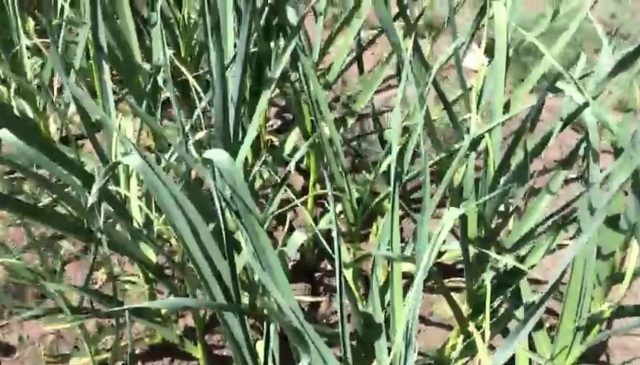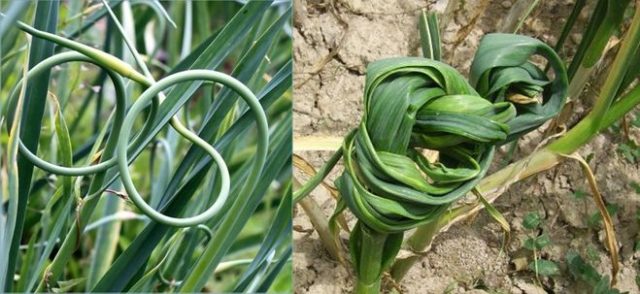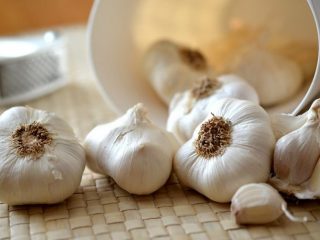Content
Experienced gardeners recommend tying garlic in knots in the garden. The plantings look unusual, which is sometimes confusing. That is why it is important for gardeners to know whether the result will really be large garlic heads or not, at what time and how to tie the tops.

Although the appearance of the plant is surprising, according to gardeners, it is definitely worth making knots from garlic tops
Why tie garlic leaves in a knot in the garden?
There is an ambiguous attitude towards tying garlic feathers in the garden. Most gardeners are confident that this method increases the access of nutrients to the heads. Broken feathers begin to gradually die and dry out. Growing experts believe that garlic cloves will increase in size. Whether this is true or not can be verified in practice.

Work in the garden should be done with gloves, as the plant secretes a burning juice.
When to tie garlic leaves in knots in the garden
Before you start tying garlic tops, you need to decide on the timing of harvesting.There are features that should not be overlooked. They are practically (with the exception of the formation of arrows and inflorescences) the same for summer and winter types of vegetables.
External signs:
- yellowing of the tips of the tops;
- coarsening of the husk on the cloves;
- curling of arrows, cracking of inflorescences;
- slight bending of the stems.
In order not to damage the vegetable, you need to start work on time. Some gardeners curl garlic feathers 4-5 days before, others 1.5 weeks before digging. The timing is also affected by the weather and climatic conditions of the region. Tying the feathers of winter and summer garlic is done at different times.
When to tie winter garlic in the head bed
Cloves planted in the fall ripen in mid-July. By this time, arrows have usually formed. It is recommended to twist knots from the 10th, taking into account the signs.
When to tie summer spring garlic for heads
The spring vegetable is planted in April, ripening dates are at the end of August. In the second half of the month, yellowing of the tops is observed, the scales of the cloves become coarser. You can check this by pulling out one plant. If the scales begin to rustle, it’s time to set leaves on the spring crop.

Curled leaves receive less nutrients and the heads ripen faster
How to tie garlic after removing the shoots
And now about how to tie garlic in the garden, how to do it correctly. Even minor mistakes will destroy the plants; the heads will not be stored for long and will crumble into individual cloves. The technique is simple, and even beginning gardeners can do it if they follow the instructions.
Stages of work:
- Before weaving braids or tying green knots, you should prepare gloves, a sterile sharp knife or pruning shears. By the time you start work, the leaves become rough and the juice becomes toxic.
- A few days before the proposed operation, it is important to remove the shoots (spring crops do not need such a procedure), only in this case you will get a high-quality node, and the tops will remain intact. Do not pull out the arrows with your hands, otherwise you may damage the teeth. It is best to cut them at an angle of 40-45° with pruning shears or a knife, leaving stubs of about 3-4 cm.
After the procedure, it is recommended to sprinkle the damaged areas with wood ash.
- Tie the garlic after the arrows break, carefully so as not to greatly crush the tops.
You need to collect all the feathers, twist them into a light rope and make a knot
There are many varieties of spring and winter garlic. They differ not only in taste, head size, but also in the length of the feathers. Sometimes the height of the green mass is not enough to set. In this case, the leaves are divided into 2 parts, twisted into a rope, then folded in half, joined together at a right angle or braided.
You can do it differently: connect 2-3 neighboring plants to each other, intertwine them. In this case, the work will go several times faster, which is important if the plantations are large.

The place where the feathers are intertwined must be strong, otherwise the wind will untie the twist
If the garlic leaves are long, you can tie 2 knots; on other plants, one is enough.
Conclusion
Whether or not to tie garlic in knots in the garden is up to each gardener to decide for himself.If the work is being done for the first time, it is better to test the method on several plants. Moreover, they experiment not for one year, but at least two. If the result pleases you, you can carry out this procedure in the following seasons.










